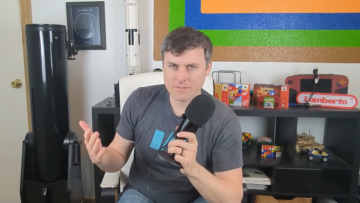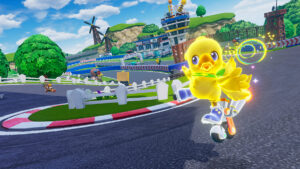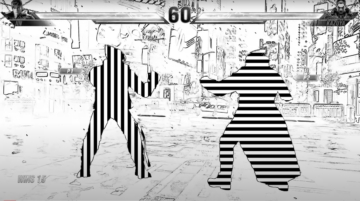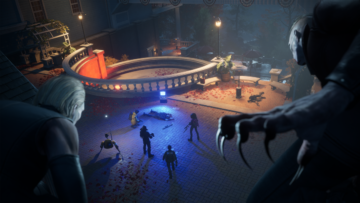Even to this day, developer Starbreeze Studios’ 2013 classic Brothers: A Tale of Two Sons is fondly remembered. This adventure puzzler was released on PlayStation 3 and Xbox 360 just months before the next console generation, and packed a real emotional punch for those that caught it. Jump forward eleven years and we have a new remake for a new generation on PS5, Series X and Series S – so how does it hold up on new platforms, including the less powerful Series S, across both performance and quality modes?
In terms of its tech, this is a significant remake: the original game’s Unreal Engine 3 is jettisoned for Unreal Engine 5, with Milan-based studio Avantgarden putting in serious work to re-imagine every environment with vastly improved detail via the engine’s Nanite and Lumen technologies. Beyond improved visuals, the release also includes new cutscenes, tweaked controls and adjustments to difficulty. Even its soundtrack was re-recorded from scratch, with original composer Gustaf Grefberg returning to the project.
Despite all of those changes though, it’s a relief to find that great care has been taken to stick closely to the original’s core gameplay design and story. From the main menu design to the physics for its puzzles, the game logic running underneath is often identical. As before, you take control of two brothers simultaneously in a top-down view, with one brother on the left analogue stick and the other on the right. The goal is to navigate an eerie, beautiful fantasy world – full of trolls, wolves and sentient trees – in a quest to find a cure for their dying father.
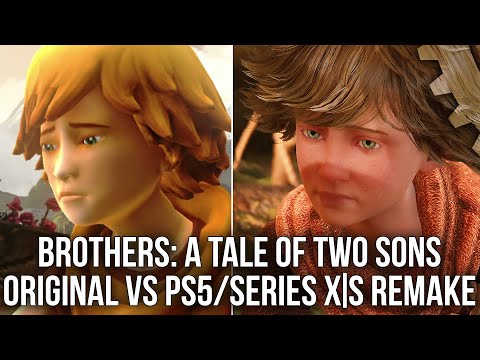 Brothers: A Tale of Two Sons Remake – PS5/XSX/S Tech Review – UE5 Nanite/Lumen Come at a Heavy Cost
Brothers: A Tale of Two Sons Remake – PS5/XSX/S Tech Review – UE5 Nanite/Lumen Come at a Heavy Cost
From the very first frame on the cliffside, the jump to Unreal Engine 5 unlocks a litany of visual upgrades. Most prominent is the reworked geometry, with Nanite deployed to help create more complex meshes that can be seen in the intricate rock formations lining the coast, the wooden planks, and the cobblestone floors of the town below. It’s in cutscenes though – above all – where the camera lies close to the ground that the benefits of Nanite stand out most. Here we see added grass and foliage detail fill out the space, greatly upgraded water shaders and more advanced post-effects like depth of field, film grain and light shafts.
The most substantial change – beyond Nanite – is the remake’s lighting, which uses UE5’s Lumen real time global illumination system. In short this allows the game to produce diffuse bounce lighting across a scene. The better examples are usually around interiors: a lit surface will now bounce light and its hue over to nearby geometry – and equally we see it at play around the darkened areas flanking bridges. It’s hugely impressive, and the way Lumen impacts shaded points with simulated light creates a much more realistic result.
It’s impossible to ignore the remake’s new character designs too. The materials used across each model see a huge improvement, with textures presenting fine stitching on cloth, while skin shaders allow for more realistic interaction with light. But the best bit is that their facial detail comes alive in the remake. We get more expressive eye animation, blinking and mouth movements, an upgrade that’s so stark that Avantgarden has adjusted the camera work and editing to squeeze in as many close-ups as possible. The 2013 original has a genuine if minimalist charm to it, even today, but it’s clear from these shots that remake benefits from these more detailed animations. Interestingly, certain cutscenes are pre-rendered now, while others are entirely new. Otherwise, much of the remake is synced up to the original.
Attribution
Thankfully, the remake avoids falling into the rather modern trap of updating all visuals at the expense of playability: the environments are still easily legible despite the new lick of paint. There’s also more ways to play here, with a proper two player co-op mode included in the remake that first debuted on the Switch original. Controls are also updated to give the running movement – and especially the turning animation – a more modern feel, with myriad smaller tweaks evident too.
Another key feature is the choice between two graphics modes on PS5, Series X and Series S: a 30fps quality mode and a 60fps performance mode. The quality mode on PS5 and Series X has an internal resolution that ranges from 1260p to 1620p, with 1440p being relatively common – and 4K not evident in our testing.
Series S fares rather worse, with its 30fps mode ranging from 454p to 720p, though often it’s at that latter figure. Unfortunately, image breakup is obvious on Series S given the low resolution, calling into mind other UE5 releases like Immortals of Aveum and Lords of the Fallen that opted for Lumen and Nanite support – in exchange for significantly lower internal resolutions. The 4TF console also runs with lower settings than the PS5 and Series X versions, with degraded shadows, textures, depth of field, grass density and ambient occlusion. That means you’ll notice bushes appear with less shading and the corners of the world will appear lighter.
The performance mode meanwhile keeps Nanite and Lumen engaged, as you’d hope, but that does mean resolution is sacrificed to double the frame-rate to 60fps. PS5 and Series X typically run at 1080p in this mode, for example, and this is accompanied by lower-quality shadows than the quality mode.
Series S, in turn, keeps the same 454p to 720p range as the quality mode but understandably is on the lower end of that scale much more frequently. This manifests with more visual noise, more artefacts, more flickering, and a softer image overall that doesn’t resolve well on 4K displays.
These visual cutbacks make the 30fps quality mode the sensible default choice on any platform, especially as this runs with even frame pacing and a locked 30fps on PS5 and Series X – and a nearly locked 30fps on Series, with only one segment on Series S that drops into the mid-20s. There are minor hitches on all platforms when the game auto-saves, but this is only mildly distracting rather than game-breaking. 60fps purists will no doubt have a bone to pick here, but Brothers is a slower-paced game that doesn’t tend to feature timing-sensitive inputs. Also, despite the heavy visual compromises on Series S – in resolution, shadows and ambient occlusion – they do at least pave the way for solid frame-rate on that quality mode.
Attribution
The performance mode seems intended for VRR-capable displays. The fact is that image quality takes a hit, and the sacrifice there doesn’t lead to a locked 60fps by any means. Most cut-scenes lock at 30fps in the 60fps mode anyway, but gameplay wavers from 35 to 60fps on both PS5 and Series X, with the latter often seeing a 10-15 percent frame-rate advantage in more demanding segments. In other words, Series X typically averages a higher frame-rate for VRR displays to work with, leading to a more perceptually smooth result. On the other hands, certain segments – such as the dungeon in the second chapter – run at a clean 60fps throughout on PS5 and Series X. If you’re able to stand the resolution and shadow quality hit on performance mode, there is a frame-rate advantage to be gleaned in this spot at least.
Performance mode on Series S pales by comparison, as its lower resolution and visual cutbacks aren’t enough to give equivalent performance to the higher-powered consoles. Series X runs around 30 percent faster than Series S in stress points around the opening town, making it hard to recommend. There is one later dungeon segment that gets closer to 720p and 60fps on Series S, but otherwise the 30fps quality mode is the better of the two options.
That’s the state of play then – Brothers: A Tale of Two Sons is handsomely remade on current-gen machines, a winsome effort based on the merits of its visual upgrade at least. The jump to Unreal Engine 5 makes way for a beautiful, fresh take on the original’s story, and the character redesigns truly benefit in closeups.
Attribution
Unfortunately, the remake also falls foul of the same Nanite and Lumen performance troubles as some other notable UE5 releases, with the game struggling to reach 60fps, even with deep image quality cuts on PS5 and Series X – not even mentioning Series S. For most cases, especially on the Series S, the 30fps quality mode at least provides a more consistent experience that makes the most sense for playability.
It’s also worth noting that the remake in its launch state does suffer from a few bugs, such as flickering shadows elements, as well as one instance where a troll boss became stuck in the geometry. A checkpoint restart was required here. The 2013 original was no stranger to these sorts of issues either, but it does need addressing.
Of course, many will have a strong attachment to Starbreeze Studios’ original work, in the name of nostalgia or because the simplistic nature of the visuals lent itself to the story. Supposing it slipped past your radar in the last 11 years though, the remake offers a great, modern way to see out the same adventure. Speaking as someone who hadn’t played any incarnation of the game until now, the story is still truly affecting, and still carries the same emotional weight – regardless of which version you pick.
- SEO Powered Content & PR Distribution. Get Amplified Today.
- PlatoData.Network Vertical Generative Ai. Empower Yourself. Access Here.
- PlatoAiStream. Web3 Intelligence. Knowledge Amplified. Access Here.
- PlatoESG. Carbon, CleanTech, Energy, Environment, Solar, Waste Management. Access Here.
- PlatoHealth. Biotech and Clinical Trials Intelligence. Access Here.
- Source: https://www.eurogamer.net/digitalfoundry-2024-brothers-a-tale-of-two-sons-remake-ue5-nanite-and-lumen-come-at-a-heavy-cost?utm_source=feed&utm_medium=rss&utm_campaign=feed
- 11
- 2013
- 2024
- 30
- 35
- 360
- 4k
- 7
- a
- able
- above
- accompanied
- across
- added
- Addressing
- adjusted
- adjustments
- advanced
- ADvantage
- Adventure
- affecting
- alive
- All
- allow
- allows
- also
- always
- an
- analysis
- and
- Animation
- animations
- any
- ARE
- areas
- around
- as
- At
- avoids
- based
- BE
- beautiful
- became
- because
- been
- before
- being
- below
- benefit
- benefits
- BEST
- Better
- between
- beyond
- Bit
- bone
- both
- bridges
- Brothers
- bugs
- but
- by
- calling
- camera
- CAN
- care
- cases
- caught
- certain
- change
- changes
- chapter
- character
- choice
- Classic
- clean
- clear
- click
- close
- closely
- closer
- come
- comes
- Common
- comparison
- comparisons
- compatibility
- complex
- consistent
- Console
- Consoles
- content
- Control
- controls
- cookie
- cookies
- Core
- corners
- cost
- course
- cover
- create
- creates
- cure
- day
- debuted
- deep
- demanding
- deployed
- depth
- Design
- designs
- despite
- detail
- detailed
- details
- Developer
- difficulty
- displays
- do
- does
- doesn
- double
- Doubt
- drops
- e
- each
- easily
- editing
- effort
- either
- elements
- eleven
- Emotional
- enable
- end
- engaged
- engine
- enough
- entirely
- Environment
- environments
- equally
- equivalent
- especially
- Eurogamer
- even
- Event
- Every
- evident
- Example
- Examples
- exchange
- experience
- eye
- facial
- fact
- falling
- falls
- false
- FANTASY
- faster
- Feature
- feel
- few
- field
- Figure
- Film
- find
- fine
- First
- floors
- For
- form
- Forward
- Frame
- frequently
- fresh
- from
- full
- gallery
- game
- gameplay
- GDPR
- generation.
- genuine
- geometry
- Get
- gets
- give
- given
- Global
- goal
- graphics
- grass
- great
- greatly
- Ground
- hands
- Hard
- has
- Have
- heavy
- help
- here
- higher
- HIT
- hold
- hope
- How
- HTTPS
- huge
- hugely
- identical
- if
- ignore
- image
- Immortals
- Impacts
- impossible
- impressive
- Improved
- improvement
- in
- Included
- includes
- Including
- inputs
- instance
- intended
- interaction
- interiors
- internal
- into
- intricate
- Is
- issues
- IT
- ITS
- itself
- jpg
- jump
- just
- Key
- Label
- large
- larger
- last
- later
- launch
- lead
- leading
- least
- left
- less
- lies
- light
- Lighting
- like
- lining
- ll
- loading
- location
- lock
- locked
- logic
- Lords
- Lords of the Fallen
- Low
- lower
- Lumen
- Machines
- main
- make
- MAKES
- Making
- manage
- many
- materials
- mean
- means
- Meanwhile
- mentioning
- merits
- Message
- mind
- minor
- mode
- model
- Modern
- modes
- months
- more
- most
- movement
- movements
- much
- myriad
- name
- Nanite
- nature
- navigate
- nearly
- need
- New
- Next
- no
- Noise
- Nostalgia
- not
- notable
- notice
- noting
- now
- obvious.
- of
- offer
- Offers
- often
- on
- One
- only
- opening
- Options
- or
- original
- Other
- Others
- otherwise
- our
- out
- over
- overall
- Packed
- paint
- Past
- PAVE
- percent
- performance
- Physics
- pick
- platform
- Platforms
- plato
- plato data intelligence
- platodata
- platogaming
- play
- played
- player
- playstation
- PlayStation 3
- please
- Points
- possible
- powerful
- presenting
- Produce
- project
- prominent
- proper
- provides
- ps4
- ps5
- punch
- putting
- quality
- quest
- radar
- range
- ranges
- ranging
- rather
- RE
- reach
- Real
- realistic
- recommend
- regardless
- relatively
- release
- released
- Releases
- relief
- Remake
- required
- resolution
- Resolve
- result
- returning
- review
- right
- Rock
- Run
- running
- runs
- s
- sacrifice
- same
- Scale
- scene
- scratch
- second
- see
- seeing
- seems
- seen
- segment
- segments
- sense
- Series
- serious
- settings
- Shadow
- Short
- shots
- significant
- significantly
- simplistic
- simultaneously
- Skin
- smaller
- smooth
- So
- solid
- some
- someone
- Soundtrack
- Space
- Speaking
- Spot
- Squeeze
- stand
- starbreeze
- State
- State of Play
- still
- Story
- stranger
- stress
- strong
- struggling
- studio
- substantial
- such
- support
- Surface
- Switch
- system
- Take
- taken
- takes
- tale
- Tap
- targeting
- tech
- Technologies
- tend
- terms
- Testing
- than
- that
- The
- The Game
- the world
- their
- then
- there
- These
- they
- this
- those
- though
- Throughout
- time
- to
- Today
- too
- town
- trees
- truly
- turn
- turning
- tweaks
- two
- typically
- ue5
- under
- underneath
- unfortunately
- unlocks
- Unreal
- unreal engine
- Unreal Engine 5
- until
- up
- updated
- upgrade
- upgraded
- upgrades
- used
- uses
- usually
- version
- versions
- very
- via
- Video
- View
- visual
- visuals
- was
- Water
- way
- ways
- we
- well
- when
- where
- while
- WHO
- will
- window
- with
- wolves
- words
- Work
- world
- worse
- worth
- X
- xbox
- Xbox 360
- years
- you
- your
- youtube
- zephyrnet


